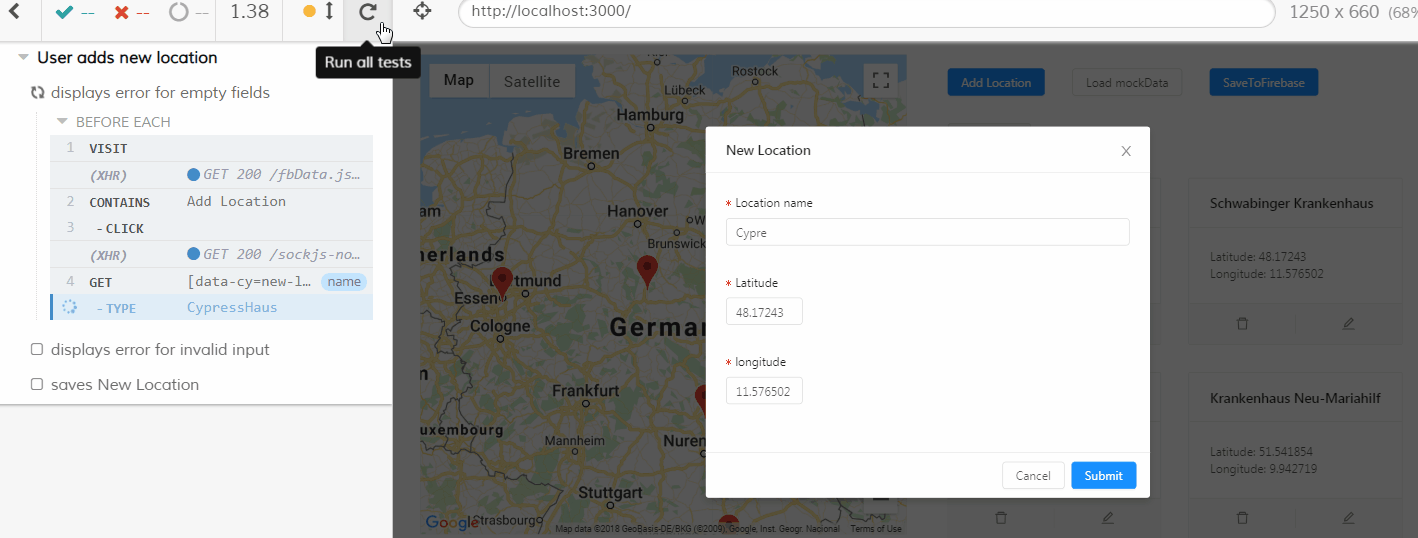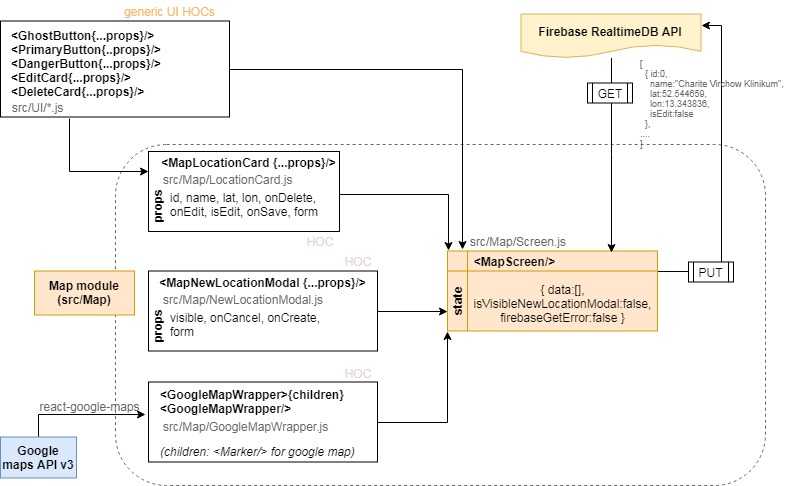React-map-app
Demo | full-stack, react, google maps, firebase, coding task
Create, edit, delete, view map locations with react and google maps API.
Preview
URL: https://react-map-app.netlify.com/
Source: https://github.com/antekai/ct-med-map/
 e2e test preview (userflow - User adds new location)
e2e test preview (userflow - User adds new location)
Installation
Install Node.js, Git and then:
git clone https://github.com/antekai/ct-med-map.git react-map-app
cd react-map-app
yarn install
yarn startNote: You have to set google map api key.
// Replace gMapKey with your own key
// src/Map/GoogleMapWrapper.js
const gMapKey = `${process.env.REACT_APP_GOOGLE_MAP_API}`;
Testing
You need to have open instance of application at localhost:3000 before using cypress. Run yarn start and then on another terminal instance run:
yarn cy:openEnd-to-End tests with cypress simulate realistic user interaction with the application. There are no stubs but real request to backend (Firebase) and Map API. Please play around sparingly
User-features
- Create, view, edit, delete map locations (React.js)
- Validate user input (getFieldDecorator, regex)
- View (synced) map locations with Google map api (React.js, react-google-maps)
- Save/load map locations to/from a backend api (axios, firebase)
Technical-features
- Design Considerations: Scalability, Portability, Maintainability
- UI: ant-design and vanilla css (flexbox layout)
- Module-based folder structure and path-based component naming
- Local state management (React.js)
- Type checking (prop-types)
- Integration, End to end(E2E) tests (cypress.io)
- Management with automated Kanban (github project)
- Continuous Deployment (Netlify CD)
- Continuous Integration (Travis CI)
- Automated versioning (semantic-release)
- Monitor bundle - report: wba-report.html (webpack-bundle-analyzer)
- Unit, integration tests (jest, react-testing-library, wallaby)
- Fallback for no 3rd party map api
- Fallback/alternative map api (mapbox)
- Fallback/alternative backend api (express.js)
Portability
The application was designed without tight coupling to backend or map APIs. Further information about switching backend or/and map APIs follows below.
Backend
Any REST api is compatible with this application. Steps to use another API:
- Create a new axios instance at
src/axios.jswith your configuration (baseURL, headers config) - Replace the GET request at
componentDidMount()and the PUT requestputToFirebase()method of the MapScreen component (src/Map/Screen.js) using the new axios instance.
3rd-party Map API
To change from google-maps to another 3rd-party MAP API follow the steps:
- Create a new react-component to handle the rendering of the map based the new 3rd-party MAP API.
- Replace
<GoogleMapWrapper/>and<Marker/>references at the MapScreen (src/Map/Screen.js) component
class MapScreen extends React.Component {
.....
render(){
.....
const dataToMarkers = this.state.data.map((item, i) => (
<Marker
key={i}
position={{ lat: item.lat, lng: item.lon }}
title={item.name}
/>
));
return (
<div className={`flexContainer margin-1`}>
{/*** MAP COMPONENT ***/}
<div className="flexItem">
{this.state.gMapError ? (
`GoogleMapAPI error - put fallback component here`
) : (
<GoogleMapWrapper>{dataToMarkers}</GoogleMapWrapper>
)}
</div>
....
)
}}
Support
Please open an issue for support.


